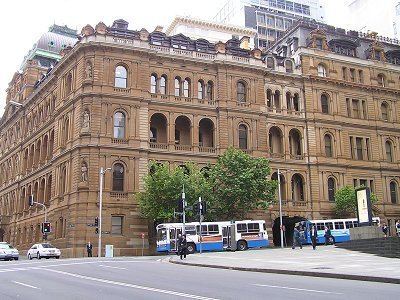Status Complete Opened 1881 Construction started 1873 | Country Australia Floors 5 | |
 | ||
Type Government administration Architectural style Victorian Free Classical Address 121 Macquarie Street, Sydney, New South Wales Current tenants Governor of New South Wales
NSW Industrial Relations Commission Owner Government of New South Wales Architects James Barnet, Walter Liberty Vernon Similar Department of Lands building, Department of Educatio, Suncorp Place, Sydney Trades Hall, Latitude | ||
Henry parkes room in the chief secretary s building in sydney
The Chief Secretary’s building (originally the Colonial Secretary's building) is a heritage-listed state government administrative building of the Victorian Free Classical architectural style located at 121 Macquarie Street, 65 Bridge Street, and at 44-50 Phillip Street in the Sydney central business district of New South Wales, Australia.
Contents
- Henry parkes room in the chief secretary s building in sydney
- Architecture
- Historical significance
- References
The ornate five-storey public building was designed by Colonial Architect James Barnet and built in two stages, the first stages being levels one to four completed between 1873 and 1881, with Walter Liberty Vernon completing the second stage between 1894 and 1896 when the mansard at level 5 and the dome were added.
The sandstone building was the seat of colonial administration, has been used continuously by the Government of New South Wales, and even today holds the office of the Governor of New South Wales. Its main occupant is the Industrial Relations Commission of New South Wales; several of the larger rooms are now courtrooms.
Architecture
Constructed 1873-1880, the building was designed by colonial architect James Barnet. Its style has been called "Venetian Renaissance" as well as Victorian Free Classical. A fifth floor and dome were added in the 1890s by Barnet’s successor Walter Liberty Vernon in the Victorian Second Empire style, as well as an extension south at 50 Phillip Street. Barnet resented the additions, which lessened the resemblance to his model, the 16th-century Palazzo Farnese in Rome, completed by Michelangelo after Farnese became Pope Paul III. The dome was originally covered in aluminium in 1895-1896, one of the earliest such uses of this metal in the world.
The building features nine life-size statues (six external and three internal) placed according to the administrative function of three parts of the building. The entrances on three streets are labelled in sandstone, directing visitors to the appropriate section.
The internal Carrara marble statues are by Giovanni Giuseppe Fontana. He was born in Italy (1821) but lived and worked in England, dying in London in December 1893. The external sandstone statues are by Achille Simonetti (Rome 1838 - Birchgrove 1900), who in 1874 established a large studio in Balmain.
The interior features Australian Red Cedar and ornate tiles, plaster ceilings and cornices.
Historical significance
The building's design and furnishings reflect in large part the taste of the first Colonial Secretary, Sir Henry Parkes.
The Executive Council Chamber (originally known as the Cabinet Room) was the venue for several meetings that led to Federation, including the Australasian Federal Convention of 1891. The room is very well preserved, with period furniture, paintings of a young Queen Victoria and James Cook, and bronzes of several British Prime Ministers including Palmerston. Some of the objects on display were acquired from the Sydney International Exhibition (1879).
Extensive restorations between 1988 and 2005 were performed with a degree of care that set new standards. It is open to the public; several historical displays interpret the building's history, and the glass lift shafts allow archaeological viewing of the construction.
